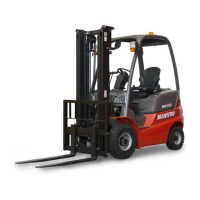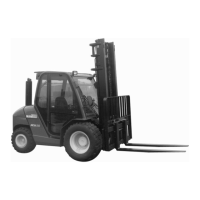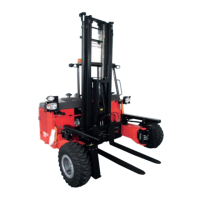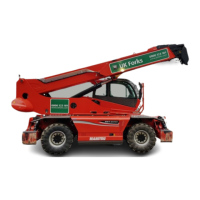14 647852EN-USM1(B-12/2021)
SAFETY
• That the unit to which it is connected (wagon,
lorry, etc.) will not shift.
• That this platform is prescribed for the total weight
of the lift truck to be loaded.
• That this platform is prescribed for the size of the
lift truck.
• Be careful in the area of loading bays, trenches,
scaffolding, soft ground and manholes.
• Make sure that the ground is stable and firm under
the wheels and/or stabilizers before lifting or
removing the load. If necessary, add sufficient
wedging under the stabilizers.
• Make sure that the scaffolding, loading platform,
pilings or ground is capable of bearing the load.
• Never stack loads on uneven ground, they may tip
over.
• When working near aerial lines, make sure there is
sufficient safety distance between the working area
of the lift truck and the aerial line.
DANGER
You must consult your local electrical agency. You could
be electrocuted or seriously injured if you operate or
park the lift truck too close to power cables.
In the event of high winds, do not carry out
handling work that jeopardises the stability of the
lift truck and its load, particularly if the load
catches the wind badly.
• Prevent fire risks associated with the use in dusty
and flammable conditions (e.g. straw, flour,
sawdust, organic waste, etc.).
Visibility
• The safety of people within the lift truck's working
area, as well as that of the lift truck itself and the
operator are dependent on good operator visibility
of the lift truck's immediate vicinity in all situations
and at all times.
• This lift truck has been designed to allow good
operator visibility (direct or indirect by means of
rear-view mirrors) of the immediate vicinity of the lift
truck during running operations, unladen and boom
in the transport position.
• Special precautions must be taken if the size of the
load restricts visibility toward the front. These
include:
• moving in reverse.
• site layout,
• assisted by a person directing the maneuver
(while standing outside the truck's area of travel),
making sure to keep this person clearly in view
always,
• in any case, do not reverse over long distances.
• If visibility of your road is inadequate, ask someone
to assist by directing the maneuver (while standing
outside the truck's area of travel), making sure to
keep this person clearly in view always.
• Keep all components affecting visibility in a clean,
properly adjusted state and in good working order
(e.g. windscreens, windows, windscreen wipers,
windscreen washers, driving and work lights, rear-
view mirrors)..
Starting the lift truck
SAFETY INSTRUCTIONS
WARNING
Risk of losing control.
Risk of losing lateral and frontal stability of the lift
truck. The operator must remain in control of the lift
truck.
In the event of the lift truck overturning, do not try to
leave the cabin during the incident. YOUR BEST
PROTECTION IS TO STAY FASTENED IN THE
CABIN.
• Observe the company’s traffic regulations or, by
default, the public highway code.
• Do not carry out operations which exceed the
capacities of your lift truck or attachments.
• Always drive the lift truck with the forks or
attachment to the transport position, i.e. at 300mm
from the ground and the carriage sloping
backwards.
• Only carry loads which are balanced and properly
anchored to avoid any risk of a load falling off.
• Ensure that pallets, cases, etc. are in good order
and suitable for the load to be lifted.
• Familiarise yourself with the lift truck on the terrain
where it will be used.
• Ensure that the service brakes are working properly.
• The loaded lift truck must not travel at speeds in
excess of 12 km/h.
• Drive smoothly at an appropriate speed for the
operating conditions (land configuration, load on the
lift truck).
• Do not use the hydraulic mast controls when the lift
truck is moving.
• Do not manoeuvre the lift truck with the mast in the
raised position unless under exceptional
circumstances and then with extreme caution, at
1.

